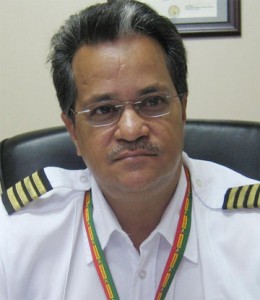`We have lost confidence in the system’
In the wake of the so far futile search for the missing United States-registered aircraft which disappeared in the interior of Guyana two weeks ago, Chairman of the Private Sector Commission (PSC) Captain Gerry Gouveia has told Stabroek Business that the Commission will be seeking to engage President Bharrat Jagdeo on the setting up of a multi-faceted national disaster and emergency response facility.
Gouveia, who is Chairman and Chief Executive Officer of Roraima Air Services Ltd told Stabroek Business that he will be consulting with Association of Aircraft Owners of Guyana prior to seeking a meeting with the President on the issue since efforts over the years by the private sector to secure the setting up of such a body have proved futile.

“It is ironic that while there have been several charges that the President is inclined to micro-manage, the various approaches that we have made to successive Ministers responsible for aviation have borne no fruit whatsoever. The importance of this issue and the fact that we are altogether dissatisfied with the responses that we have had from the various Ministers responsible for aviation now mean that we have no choice but to resort to the President,” Gouveia said.
Asked to comment on the ongoing search for the missing aircraft and its two-member crew and passenger, Gouveia, a graduate of the National Transport Safety Board (NTSB) in Washington DC said that he was sure that the search contingent was doing a professional job under difficult circumstances. ”It is important that a distinction be made between the brave and competent contingent engaged in the operation to find the missing aircraft, crew and passenger and the fact that at the end of the day we still lack a competent machinery to deal effectively with search and rescue operations,” Gouveia said.
Noting that the private sector had long lost confidence in the national search and rescue regime, Gouveia, who himself had to wait several hours to be rescued following a 1994 aircraft accident, told Stabroek Business that the local Aircraft Owners Association had established its own search and rescue system using their own private aircraft. “Apart from the fact that we have placed this system at the disposal of the authorities we have, time and again, indicated to the authorities our willingness to work with them in the setting up of a national search and rescue facility involving the public and private sectors. We have not had a positive response,” Gouveia said.
And according to the former Chief Pilot of the Guyana Defence Force the links between the interior of Guyana and the various industries that are critical to the country’s economy ought to make domestic aviation and the development of an effective search and rescue capacity a national priority.
“Quite apart from the need for us to create a competent search and rescue capability in support of what has long been an excellent safety regime, there is also the need to recognize the importance of an aviation and search and rescue capacity that provides adequate support for some of our key and critical industries like mining, logging and tourism,” Gouveia said.
According to Gouveia while aviation in Guyana was “generally very safe” there were some issues that required attention. “The country is void of ground navigation aids and a lot of the flying that is being done in Guyana is being done on the basis of pilots’ knowledge of the area and with the aid of satellite navigation systems. Guyana, on its own, does not have any navigation aids to help the pilots as they fly across this vast country, “We also face the challenge of inadequate airstrips.
Most of the airstrips are small and the surfaces of the runways are defective and there is also the issue of the terrain Gouveia said. And according to the former Head of the search and rescue contingent of the local Aircraft Owners’ Association, in such circumstances the question of Guyana’s search and rescue capacity assumes an additional significance. “If there is a problem and the aircraft is overdue this is where we get into extremely murky waters since our national search and rescue system is virtually non-existent. What we have is an ad hoc, piecemeal and unacceptable system,” Gouveia said.
Gouveia told Stabroek Business that while Guyana’s search and rescue system was reasonably intact up to around 1986, since then there has been “a serious decline in organization and in the will to keep it going,” Search and rescue operations in Guyana have traditionally been coordinated by the Guyana Civil Aviation Authority and led by the Guyana Defence Force and Captain Gouveia said that the central role of the military in search and rescue operations had to go with its assets including its men and material and the specialized training available to soldiers.




